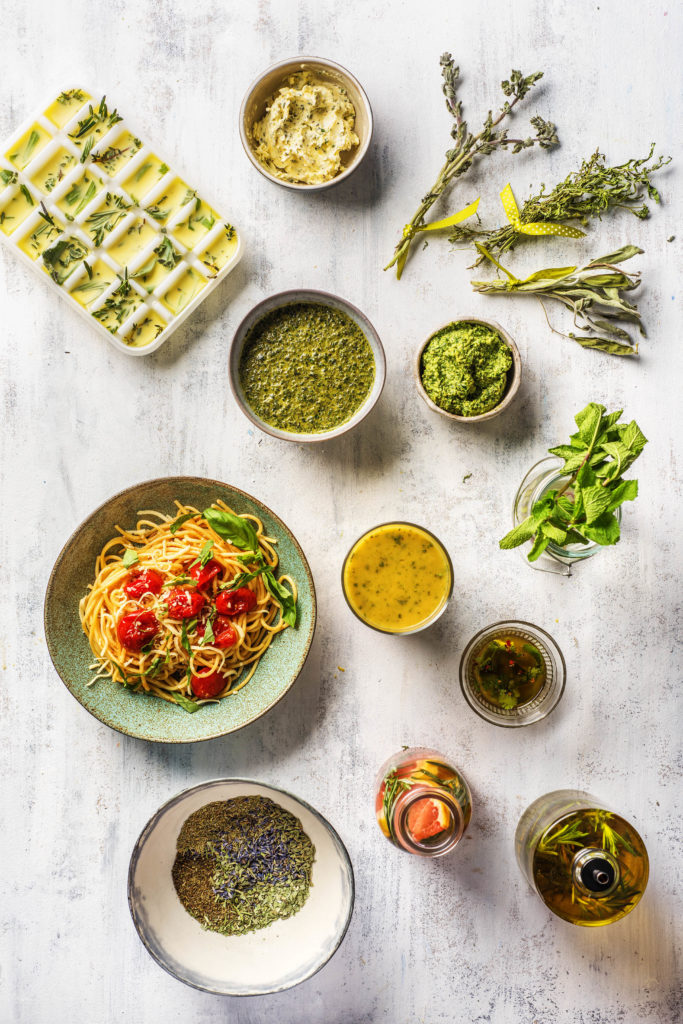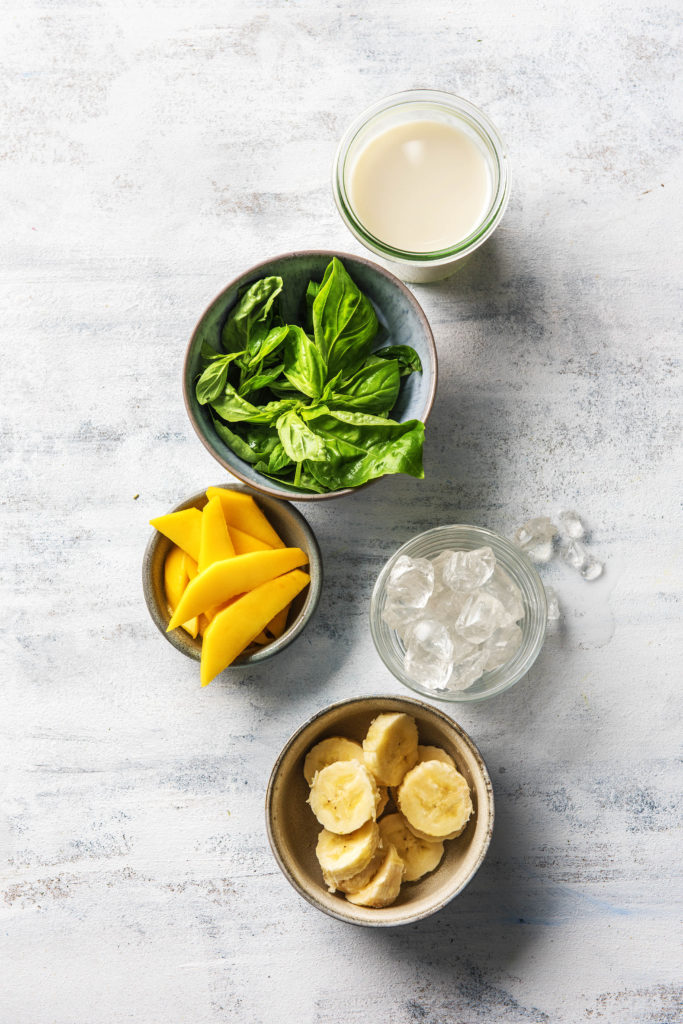10 Ways to Repurpose Leftover Fresh Herbs July 28, 2020
Don’t let those fresh herbs go to waste!
One of the best things about HelloFresh is that everything comes pre-measured and packed to perfection, which means you get exactly what you need. Nothing more, nothing less. One teaspoon of garlic powder? Done. 1/4 cup sour cream? No problem. Two garlic cloves? You bet.
But sometimes, despite our best efforts, we end up with more fresh herbs than necessary. It happens, but that doesn’t mean they have to go to waste — and we’ve got the recipes, inspiration, and how-tos to prove it. 10 of them, actually.
1. Freeze into ice cubes
By freezing herbs in oil, you can have an immediate flavor booster on hand at all times as a base for stews, soups, and roasts. Why oil and not water? Turns out preserving herbs this way reduces the chances of freezer burn.
Keep in mind, though, that this works best with tougher herbs like rosemary, sage, oregano, and thyme.
2. Dry and make spice blends
Behold the kitchen trick as old as time…drying! For thousands of years, this was the only way to keep fresh herbs from spoiling, and it hasn’t lost it’s appeal — especially when it comes to tarragon, lavender, rosemary, thyme, and lemon balm.
Simply tie sprigs or branches into small bunches and hang downward. Depending on the size of the branches and humidity, it may take 8-10 days to dry completely. To speed up the process, lay each herb out separately on cheesecloths to create a makeshift rack, and store for 2-3 days in a warm, airy spot out of direct sunlight.
You’ll know the drying process has run its course when the herbs crumble easily. That’s your cue to start experimenting with spice blends like Herbs de Provence. With equal parts savory, thyme, rosemary, basil, tarragon, and lavender, Herbs de Provence is a simple way to jazz up chicken, fish, or potatoes before roasting — just like our chefs did with Herbs de Provence Chicken with a Farro Caprese Salad.
3. Make pesto
Pesto, which is Italian for “pounded,” is an uncooked sauce that originated in Genoa, Italy. It’s traditionally made with fresh basil, garlic, pine nuts, Parmesan cheese, and olive oil, but we had a feeling other herbs and nuts would work, too. So we embarked on an ambitious game of pesto musical chairs to test and taste different combos until we reached a slightly sweet, tad bit spicy, perfectly creamy, and all-around delicious sweet spot for all that leftover cilantro lurking in your fridge.
Ingredients:
- 2 Green Chile Peppers
- 1/3 Cup Cilantro, chopped
- 1/4 Cup Olive Oil
- 1/3 Cup Walnuts
- 1 Teaspoon Honey
- Parmesan Cheese, to taste
- Salt, to taste
Instructions:
- Add chile peppers, cilantro, and olive oil into a food processor. Pulse until combined but not smooth.
- Roughly chop walnuts. Add to food processor with a pinch of salt. Pulse until combined, adding more olive oil or water if too thick.
- Add honey and pulse again.
- Grate in Parmesan, season to taste with salt and pepper, and stir to combine.
In the mood for pesto but stuck with basil instead of cilantro? We’ve got you covered.
4. Make chimichurri

Chimichurri is to Argentina what ketchup is to the United States. In other words, a staple. Although this herby, garlicky sauce is typically drizzled on grilled beef and fish, we have a feeling it would taste divine on pretty much anything, to be honest.
Ingredients:
- 1 Tablespoon Cilantro, finely chopped
- 1/2 Teaspoon Cumin
- 3 Tablespoons Olive Oil
- 1 Clove Garlic, minced
- Chili Flakes, to taste
- Squeeze of Lemon
Instructions:
- Combine cilantro, cumin, olive oil, garlic, chili, and a squeeze of lemon in a small bowl.
- Season generously with salt and pepper.
5. Blend into smoothies
The idea of drinking fresh herbs may sound foreign, but with the help of fruit for sweetness and almond milk for creaminess and depth, fragrant herbs can be wonderful accompaniments to refreshing smoothies. In this recipe, we put basil to the test. And boy, did it pass with flying colors.
Ingredients:
- 1 1/2 Cups Almond Milk
- 1 Mango, cut into chunks
- 1/2 Cup Basil Leaves (no stems)
- 1 Banana
- 1/2 Cup Ice
Instructions:
- Combine all ingredients in a blender and blend, blend, blend until it reaches desired smoothness. Add more almond milk if too thick.
6. Make infused olive oil
Olive oil is great, but herb-infused olive oil? Whoa. Now you’re talking. Here’s how to make the herby magic happen with one of our favorites, rosemary:
- Wash and thoroughly dry the rosemary. Make sure there’s no lingering water, otherwise you run the risk of bacteria growth.
- Find a bottle with a good seal that’s… you guessed it… also washed and thoroughly dried.
- Add rosemary to the jar, cover with olive oil, seal, and let sit in a cool, dark place for 1-2 weeks.
- Drizzle to your heart’s content on pasta, bread, marinades, soups, pizza, eggs, etc, etc, etc.
7. Flavor butter
Your toast won’t know what hit it.
We opted for thyme here, but feel free to experiment with scallions, dill, and flat-leaf parsley, too.

Ingredients:
- 1 Clove Garlic, minced
- 1 Stick (1/2 Cup) Unsalted Butter, softened
- 1/4 Teaspoon Salt
- 2 Teaspoons Lemon Zest
- 2 Teaspoons Thyme, chopped
Instructions:
- Use the flat side of a heavy knife to mash garlic to a paste, then transfer to a food processor with remaining ingredients. Blend until well combined.
- Roll mixture into a log on a sheet of plastic wrap. Twist ends to close and chill, covered, 2-3 hours.
- Bring to room temperature before eating.
8. Whisk into salad dressing
For all the salad haters out there, the people who are convinced that lettuce is flavorless and best left to the grazing cows (you know who you are)… this salad dressing is here to prove you wrong. Salad can, in fact, be flavorful. Delicious, even. The trick is to dress it in style — and this basil and chili dressing is as stylish as it gets.
Ingredients:
- 1 Green Chile Pepper (with or without seeds, depending on your spice tolerance)
- 1/2 Cup Arugula
- 1/2 Cup Packed Fresh Basil
- 1/2 Cup Extra Virgin Olive Oil
- 1/2 Teaspoon Finely Grated Lemon Zest
- 1/4 Cup Fresh Lemon Juice
- 1/2 Teaspoon Sugar
- Salt and Black Pepper
Instructions:
- Puree chile pepper, arugula, basil, extra virgin olive oil, lemon zest, lemon juice, and sugar in a blender until smooth.
- Season to taste with salt and pepper.
9. Replant them
Just because fresh herbs are cut doesn’t mean they can’t be replanted. The trick is to place them in enough cold water to immerse the stems but keep the leaves above. Lightly cover with a plastic bag and they may very well sprout roots after 1-2 weeks at room temperature.
Pictured here is mint, but this can also work for sage, basil, and rosemary.
Once roots sprout, transfer them to moist, well-draining potting soil.
10. Infuse water
Let’s talk about our good old friend, H20.
We cook with the stuff, shower in it, and guzzle it down after a long run. Sparkling or flat, loaded with ice or lukewarm, water is the classic thirst-quencher as old as time itself. The only bad part? It tastes like, well, nothing. Until fresh herbs show up, that is.
Infused water is the perfect way to jazz up tasteless drinks without adding extra sugar, calories, or artificial flavors. Added bonus: it’s GORGEOUS.
Our favorite combo is rosemary and grapefruit, but feel free to mix and match to your heart’s content with other citrus fruits (lemon/lime), berries (strawberries/raspberries/blueberries), and herbs (mint/basil).
A few things to keep in mind:
- Infused water can stay out of the fridge for a max of two hours. After that, there’s a risk of bacterial growth.
- Unpeeled citrus lends a bitter taste to water after four hours, so if you’re planning to make a big batch to last the afternoon, peel off the skin before infusing.
- To save the water for the next day, strain out the solids before refrigerating for two to three days.
The last thing you want is to reach for those leftover fresh herbs and find then well past their prime, which is why it’s important to learn how to correctly store them.



























